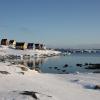
The main goal of Nunataryuk is to determine the impacts of thawing land, coast and subsea permafrost on the global climate and on humans in the Arctic and to develop targeted and co-designed adaptation and mitigation strategies.
Most human activity in the Arctic takes place along permafrost coasts and these coasts have become one of the most dynamic ecosystems on Earth. Permafrost thaw is exposing these coasts to rapid change, change that threatens the rich biodiversity, puts pressure on communities and contributes to the vulnerability of the global climate system. NUNATARYUK will determine the impacts of thawing coastal and subsea permafrost on the global climate, and will develop targeted and co-designed adaptation and mitigation strategies for the Arctic coastal population.
NUNATARYUK brings together world-leading specialists (26 partners from 11 countries) in natural science and socio-economics to:
- develop quantitative understanding of the fluxes and fates of organic matter released from thawing coastal and subsea permafrost;
- assess what risks are posed by thawing coastal permafrost, to infrastructure, indigenous and local communities and people’s health, and from pollution;
- use this understanding to estimate the long-term impacts of permafrost thaw on global climate and the economy.
IIASA is primarily involved in WP8: Modelling. The aim of WP8 is to implement knowledge and data synthesized in the project into the Earth System Modelling framework and to provide estimates of economic costs of permafrost thaw using Integrated Assessment modelling approach. Currently, despite the vast carbon stocks contained within land and subsea permafrost, it is either not represented at all in ESMs, or limited to a one dimensional description of the land permafrost without lateral exchange (Vonk and Gustafsson, 2013). The neglect of subsea permafrost, in particular, is a major weakness. Both sub-permafrost and intra- permafrost carbon stocks, whether in the form of buried vegetation/soil or as preformed greenhouse gas, are poorly constrained, in terms of distribution, amount and source (McGuire et al. 2009). WP8 aims at addressing these omissions.
The specific objectives of WP8 are:
- O8.1: Implement knowledge and data synthesized in the project into Earth System Models.
- O8.2: Perform modelling and evaluation of CO2 and CH4 fluxes from sub-sea permafrost and coastal permafrost regions on pan-Arctic scale.
- O8.3: Provide projections of permafrost-caused CO2 and CH4 emissions based on several CMIP6 scenarios, as well as estimates of economic costs of these emissions using Integrated Assessment modelling approach.

